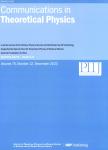Systematic Study on Alpha Decay Half-Lives of Superheavy Nuclei
Systematic Study on Alpha Decay Half-Lives of Superheavy Nuclei作者机构:School of Nuclear Science and Technology Lanzhou University Lanzhou 730000 China Institute of Modern Physics the Chinese Academy of Sciences Lanzhou 730000 China Research Center of Nuclear Theory of Laboratory of Heavy Ion Accelerator of Lanzhou Lanzhou 730000 China
出 版 物:《Communications in Theoretical Physics》 (理论物理通讯(英文版))
年 卷 期:2007年第48卷第3X期
页 面:545-552页
核心收录:
学科分类:07[理学] 0704[理学-天文学] 070202[理学-粒子物理与原子核物理] 0702[理学-物理学]
基 金:The project supported by National Natural Science Foundation of China under Grant Nos. 10505016 and 10575119 the Knowledge Innovation Project of the Chinese Academy of Sciences under Grant Nos. KJCX2-SW-N17 KJCX.SYW.N02 Major State Basic Research Development Program under Graalt No. 2007CB815000 and the Financial Support from DFG of Germany tCorresponding author
主 题:superheavy nucleus alpha decay life time
摘 要:The α-decay half-lives of a set of superheavy nuclear isotope chain from Z = 105 to 120 have been analyzed systematically within the WKB method, and some nuclear structure features are found. The decay barriers have been determined in the quasi-molecular shape path within the Generalized Liquid Drop Model (GLDM) including the proximity effects between nucleons in a neck and the mass and charge asymmetry. The results are in reasonable agreement with the published experimental data for the alpha decay half-llves of isotopes of charge 112, 114, and 116, of the element 294118 and of some decay products. A comparison of present calculations with the results by the DDM3Y effective interaction and by the Viola-Seaborg-Sobiczewski (VSS) formulae is also made. The experimental a decay half lives all stand in between the GLDM calculations and VSS formula results. This demonstrates the possibility of these models to provide reasonable estimates for the half-lives of nuclear decays by a emissions for the domain of SHN. The half-lives of these new nuclei are thus well tested from the reasonable consistence of the macroscopic, the microscopic, the empirical formulae and the experimental data. This also shows that the present data of SHN themselves are consistent. It could suggest that the present experimental claims on the existence of new elements Z =110 - 118 are reliable. It is expected that greater deviations of a few SHN between the data and the model may be eliminated by further improvements on the precision of the measurements.



